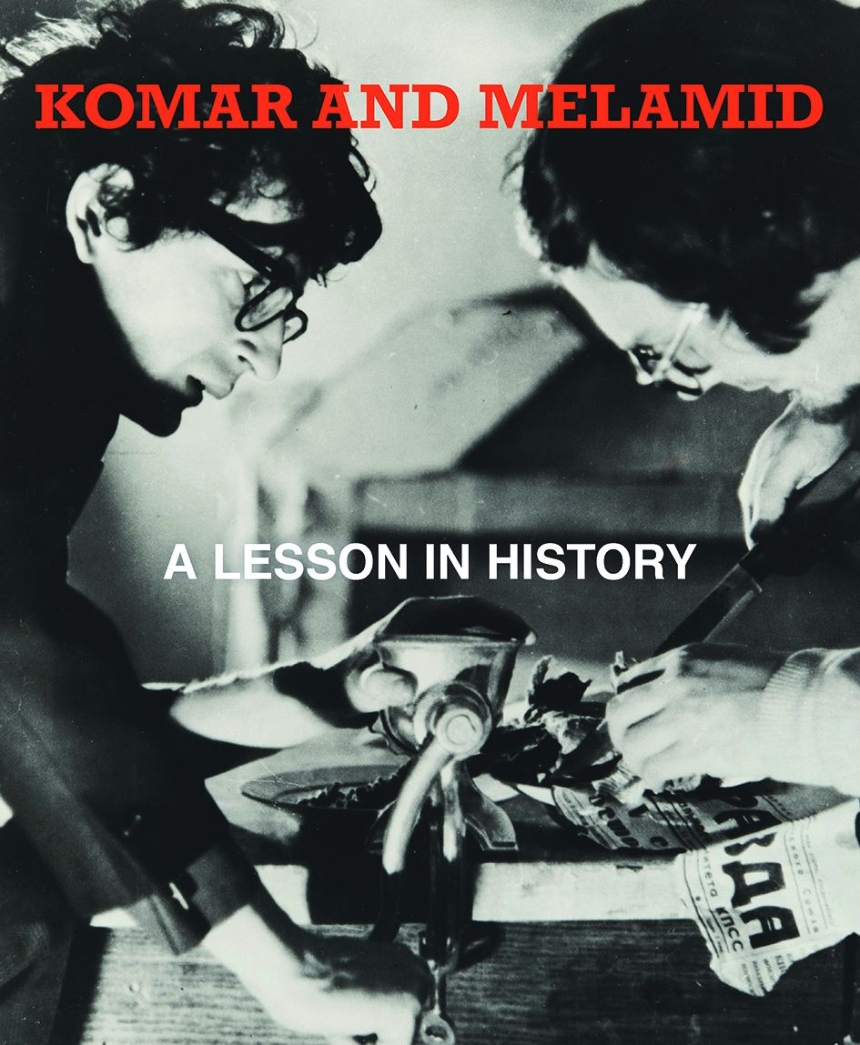Tracing a subversive artistic partnership that lambasted Soviet officialdom and American capitalism.
Among the most compelling figures in the history of conceptual art, the Russian-American artists Vitaly Komar and Alexander Melamid built their reputations by challenging viewers with controversial, witty, and ironic art. Komar & Melamid: A Lesson in History offers a comprehensive view of this trailblazing duo, who worked together from the late 1960s through 2004.
In response to the overproduction of ideology that rendered Communist slogans and symbols nonsensical, Komar & Melamind founded the Sots Art movement in the early 1970s in the Soviet Union. Incorporating elements of pop art and Dadaism, Sots Art aimed to expose the absurdities of official art, which was limited to socialist realism. Harassed by the state and barred from traveling to their first international exhibit, Komar & Melamid responded by creating a “Trans-State” with passports and a constitution before emigrating to Israel and eventually the United States, where the follies of market-driven culture offered new subjects for their provocative critique. Andy Warhol famously donated his soul to the artists, which they sold for thirty rubles during We Buy and Sell Souls, a 1979 performance. The Most Wanted Paintings used market research to create images that were designed to please mass audiences in different countries, a flippant response to populist Soviet art.
Komar & Melamid: A Lesson in History accompanies the first museum retrospective in the United States after the split of the couple to show the artists’ joint work. Held at the Zimmerli Art Museum at Rutgers University in 2023, the exhibit explores Komar & Melamid’s artistic evolution, spotlighting their social and political concerns. Featuring full-color illustrations and recent scholarship on the duo, the catalog highlights the enduring relevance of the artists’ work, which sheds light on topics like the nature of personal freedoms in a totalitarian state, cultural exchange during the Cold War, and the expression of political differences through art.
Among the most compelling figures in the history of conceptual art, the Russian-American artists Vitaly Komar and Alexander Melamid built their reputations by challenging viewers with controversial, witty, and ironic art. Komar & Melamid: A Lesson in History offers a comprehensive view of this trailblazing duo, who worked together from the late 1960s through 2004.
In response to the overproduction of ideology that rendered Communist slogans and symbols nonsensical, Komar & Melamind founded the Sots Art movement in the early 1970s in the Soviet Union. Incorporating elements of pop art and Dadaism, Sots Art aimed to expose the absurdities of official art, which was limited to socialist realism. Harassed by the state and barred from traveling to their first international exhibit, Komar & Melamid responded by creating a “Trans-State” with passports and a constitution before emigrating to Israel and eventually the United States, where the follies of market-driven culture offered new subjects for their provocative critique. Andy Warhol famously donated his soul to the artists, which they sold for thirty rubles during We Buy and Sell Souls, a 1979 performance. The Most Wanted Paintings used market research to create images that were designed to please mass audiences in different countries, a flippant response to populist Soviet art.
Komar & Melamid: A Lesson in History accompanies the first museum retrospective in the United States after the split of the couple to show the artists’ joint work. Held at the Zimmerli Art Museum at Rutgers University in 2023, the exhibit explores Komar & Melamid’s artistic evolution, spotlighting their social and political concerns. Featuring full-color illustrations and recent scholarship on the duo, the catalog highlights the enduring relevance of the artists’ work, which sheds light on topics like the nature of personal freedoms in a totalitarian state, cultural exchange during the Cold War, and the expression of political differences through art.
Table of Contents
Director’s Foreword and Acknowledgments by Maura Reilly
Introduction by Julia Tulovsky
Andrei Erofeev: Essay on Komar and Melamid’s years in the Soviet Union
Robert Storr: Essay on Komar and Melamid from an American art perspective
Ksenia Gurshtein: Essay on Komar and Melamid’s influence on a younger generation of artists
Mikhail Iampolsky: A Question of Style: Between “Eclecticism” and the “Grand Style”
Reprint of several key texts by Komar and Melamid. (Julia and the artists to select)
Checklist of the exhibition (approximately 175 objects, 125 illustrations)
Selected bibliography
Index
Author bios (brief)
Introduction by Julia Tulovsky
Andrei Erofeev: Essay on Komar and Melamid’s years in the Soviet Union
Robert Storr: Essay on Komar and Melamid from an American art perspective
Ksenia Gurshtein: Essay on Komar and Melamid’s influence on a younger generation of artists
Mikhail Iampolsky: A Question of Style: Between “Eclecticism” and the “Grand Style”
Reprint of several key texts by Komar and Melamid. (Julia and the artists to select)
Checklist of the exhibition (approximately 175 objects, 125 illustrations)
Selected bibliography
Index
Author bios (brief)

